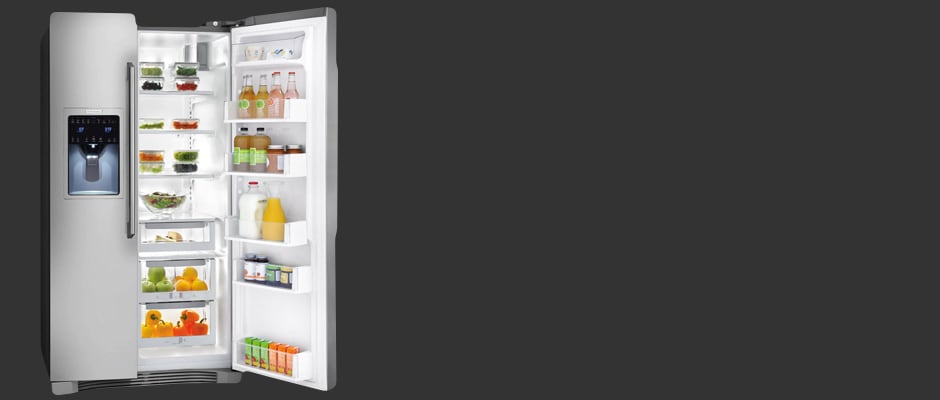Pros
Cons
Introduction
That's not to say the Electrolux EI26SS30JS isn't a good appliance. Temperatures in both the fridge and freezer were excellent with respect to long-term consistency, and you get plenty of space in both compartments. However, when you throw in the lack of readily available discounts on this newer model (the best price we found was $1,699), as well as the relative paucity of stores offering it for sale, you might as well skip it.
Design & Usability
{{section_header}}{{section.name}}{{/section_header}}
A few design touches make this appliance stand out from the slew of other models with similar looks.
This rectangular behemoth has a stainless steel exterior with a control panel located on the outside of the freezer door, immediately above the through-the-door ice and water dispenser. If smudging were a crime, the stainless front of this appliance would be painfully guilty, and the police would have no problem lifting fingerprints.
The inside of this Electrolux is fairly typical for a side-by-side: freezer on the left, fridge on the right. Shelves are made primarily with glass and have a thin, white plastic trim. Taking a cue from the truly higher-end appliances, the lights inside both apartments come on gradually, although this fridge uses incandescent bulbs instead of LEDs.
The main portion of the fridge is broken up into three adjustable shelves, one fixed shelf, and three drawers. The shelves mount to the rear using plastic hooks. It’s actually the set of drawers that provide the most interesting variation on the traditional fridge design. The top one is labeled the “Chill Zone” and has an adjustable temperature control. The middle is called the “Fresh Zone” and is divided into two sections whose humidity can be adjusted independently of each other. The third and lowest drawer—the least interesting, without any snappy name of its own—serves as a standard vegetable drawer, also with adjustable humidity. The fridge door is made up of a dairy bin at the top, three large adjustable bucket shelves below that, and two smaller fixed shelves at the bottom. Nothing remarkable here—just more white and translucent plastic.
A good chunk of the top portion inside the freezer is taken up by the ice maker. The only two fixed shelves are located underneath this section, and just below these shelves is a short pull-out drawer. At the very bottom are two taller drawers that are made of wire. The freezer door has four rather small shelves: one above the ice maker’s dispenser, and three below. None of those shelves is adjustable. Like the fridge, there’s nothing terribly unique about this layout.
{{photo_gallery "Front Photo", "Fingerprints Photo", "Handle Photo", "Handle Detail Photo", "Water/Ice Dispenser Photo", "Water/Ice Dispenser Controls Photo", "Water/Ice Dispenser Detail Photo", "Interior Photo", "Refrigerator Main 1 Image", "Refrigerator Main 2 Image", "Refrigerator Main 3 Image", "Water Filter Photo", "Refrigerator Door 1-1 Image", "Refrigerator Door 1-2 Image", "Refrigerator Door 1-3 Image", "Refrigerator Door 2-1 Image", "Refrigerator Door 2-2 Image", "Refrigerator Door 2-3 Image", "Freezer Main 1 Image", "Freezer Main 2 Image", "Freezer Main 3 Image", "Freezer Door 1 Image", "Freezer Door 2 Image", "Freezer Door 3 Image", "Ice Maker Photo", "Back Photo", "Back Detail Photo", "Sides Photo", "Side Detail 1 Photo", "Side Detail 2 Photo", "Fridge Temperature Image", "Freezer Temperature Image", "Vegetable Drawer Photo", "Vegetable Drawer Controls Photo", "Ease of Access Photo", "Controls Photo", "Cleaning Photo", "Other Features Photo"}}
Features
{{section_header}}{{section.name}}{{/section_header}}
A very accessible fridge, despite the bulky ice container
The shelves are all very easy to access in both compartments and there’s even an added accessibility bonus in the fridge: The glass portion of the shelf slides out, allowing even easier access to items in the back. Drawers in both compartments slide in and out with relative ease, but they’re not ideal: They don’t line up perfectly straight and can occasionally get stuck. Overall, the interior of the fridge doesn't match its high design and high-end pricetag.
Controls for the Electrolux are very easy to use, if a bit busy visually. The use of pictures and text labels means consumers with either preference will be satisfied, but unlike control panels that use only digital displays, these pictures and labels never turn off. They don’t glow, but they still add a bit of clutter to the front of the fridge. Small red lights are easy to see and indicate which features are currently selected. Despite the smooth console surface, all buttons respond promptly without any forceful pushing, making for a smooth interactive experience. You’ll want to make sure you save the manual, though, as features like “Vacation Mode” aren’t necessarily that common.
The water and ice come out of the same spout, and the cavity is big enough to accommodate even larger drinking glasses. Inside, though, the ice maker is quite bulky. It is powered on or off using a flip switch located on the actual device. The device and the switch are covered by a removable plastic front. To get ice in bulk, you can either remove the cover or pull out the full ice tray.
Performance
{{section_header}}{{section.name}}{{/section_header}}
Strong temperature consistency is tainted by lengthy freezing times and poor moisture retention.
We set all fridges to their manufacturer recommended temperatures, and in the case of fridges with digital displays, this usually means 37 degrees Fahrenheit. In the case of this Electrolux, however, the inside of our test materials never got colder than 39 degrees. Fortunately, temperatures never fluctuated more than a third of a degree, which means your food will remain consistent regardless.
Because it's hard to circulate air through a tall, narrow chamber, many side-by-sides suffer from inconsistent temperatures from top to bottom. This particular model did a good job, although the very bottom of the fridge was substantially warmer than the rest: 46 degrees Fahrenheit. But this is actually an ideal temperature for some produce, so just keep that in mind.
The freezer stayed about a degree or three warmer than the thermostat said, but the real problem was with temperature consistency over time. The Electrolux’s freezer fluctuated about half a degree over 72 hours of testing—not terrible, but any more of a shift and your food would likely be at a higher risk of freezer burn.
An average fridge in this product’s price range will possess two separate crisper drawers, each with its own humidity control. The Electrolux is unusual in that it has one standard drawer and a second that is divided by a plastic barrier, with the humidity of each half controlled separately. We tested the moisture retention of one of these half-drawers and the results were so unusually poor that we ran the test again—to similarly lousy results.
Since this Electrolux is a fairly large appliance, it’s going to cost a fair amount of money to run. Using a standard rate of $0.09 kWh, this machine will run up an annual bill of about $61.87. This is higher than average, generally speaking, but fridges this size tend to create energy bills that are on the higher end of the spectrum.
Conclusion
{{section_header}}{{section.name}}{{/section_header}}
An aesthetically pleasing fridge that disappoints with its performance
The Electrolux EI26SS30JS has a lot going for it: plenty of storage space, a number of extra features that aren’t usually found on models in its price range, and a surprisingly high level of access. The nicest design element here is the fact that fridge shelves slide out and the freezer has mostly pull-out drawers. This means getting to food in the back—usually a big hassle for the skinny side-by-sides—is that much easier. Controls come with clear pictures and text, making them a snap to use, though you’ll want to hang on to the manual to refresh yourself on all the extra features added into this machine.
However, the core elements of a fridge—its performance in freezing and refrigerating your food—proved to be mediocre. The unusually poor moisture retention in the vegetable drawer was disappointing, as was the temperature fluctuation in the fridge, and the interior that felt cheaper than it looked.
Science Introduction
{{section_header}}{{section.name}}{{/section_header}}
Temperature consistency over time was more or less stable, so food should be fairly well cared for in the Electrolux EI26SS30JS. Also of note: The vegetable drawer exhibited surprisingly high rates of moisture loss, so you’ll want to keep a close eye on your fresh produce. Unfortunately, the freezer failed our power loss test, with food defrosting after a relatively short period. The freezer performance was also disappointing.
Fridge Temperature
{{section_header}}{{section.name}}{{/section_header}}
The temperature on the fridge didn't match the temperature of our test materials.
When we set the fridge temperature to 37 degrees, like we do with all fridges, we noticed that our test materials never reached an internal temperature cooler than 39 degrees. If you purchase this Electrolux, make sure to turn the temperature down. Temperature fluctuation over time was not an issue at at all, so food will stay fresher.
Over the course of three days, this fridge’s crisper drawer lost moisture at a rate of about 0.35 grams per hour. To put that into perspective, a decent fridge would lose an average of about 0.10 grams less than that per hour—not the most friendly fridge for preserving produce. You’ll want to make sure you use any fresh fruit and vegetables quickly, or buy in slightly smaller quantities than you would otherwise.
{{photo_gallery "Science Section 1 Images"}}
Power Loss
{{section_header}}{{section.name}}{{/section_header}}
In case of a power outage, keep your fingers crossed that your electric company fixes the problem quickly.
We simulate a power outage simply by pulling the plug on our appliances and seeing how well the freezer insulation does its job. After only 18 hours and 24 minutes, food in the Electrolux had completely defrosted. We typically like to see food stay frozen after 36 hours, so this result is very poor.
{{photo_gallery "Science Section 2 Images"}}
Freezing Performance
{{section_header}}{{section.name}}{{/section_header}}
A surprisingly poor freezer performance
Taking longer than we’d like, the Electrolux froze our room temperature materials in one hour and 57 minutes. The longer it takes to freeze an item, especially meat or fish, the greater the chance it will have a diminished texture when thawed. We expected a better result from a fridge with this price tag.
Also, the freezer suffered from a slightly inaccurate thermostat. Even though the console stated the freezer was at a solid zero degrees, our materials registered an average temperature of two to three degrees. It’s still frozen, but the discrepancy is worth mentioning.
{{photo_gallery "Science Section 3 Images"}}
Other Tests
{{section_header}}{{section.name}}{{/section_header}}
{{photo_gallery "Other Tests Images"}}
Meet the tester
Matthew is a native of Brockton, Mass., and a graduate of Northeastern University, where he earned a degree in English and Theatre. He has also studied at the Gaiety School of Acting in Dublin, Ireland, and spends time pursuing a performance career in the greater Boston and Cambridge area.
Checking our work.
Our team is here to help you buy the best stuff and love what you own. Our writers, editors, and experts obsess over the products we cover to make sure you're confident and satisfied. Have a different opinion about something we recommend? Email us and we'll compare notes.
Shoot us an email

